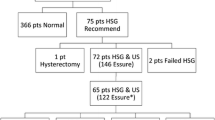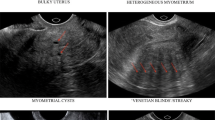Abstract
Background
The European Society of Human Reproduction and Embryology–European Society for Gynaecological Endoscopy (ESHRE–ESGE) system is designed mainly for clinical orientation; its overdiagnosis of septate uteri was confirmed in a general population in comparison to the American Society of Reproductive Medicine (ASRM) supplemental classification proposed by Ludwin. However, the agreement among septate uterus recognition using the ESHRE–ESGE and the supplemental ASRM classifications and the rate of overdiagnosis of septate uterus by ESHRE-ESGE in infertile women remain unclear.
Methods
We conducted a retrospective study of 53,540 infertile patients in our reproductive centre from June 2013 to December 2016, to compare septate uterus recognition using three systems. The data were analysed by the ESHRE–ESGE system, the ASRM by Salim and the ASRM by Ludwin separately. The concordance of diagnoses of septate uteri using these three systems was compared.
Results
ESHRE–ESGE classification significantly increased the frequency of septate uteri (11.31%, 6056 vs. 7.20%, 3854 vs. 3.80%, 2034). Good agreement was observed between the ESHRE-ESGE and the ASRM by Salim (k = 0.686, p < 0.001) and between the ASRM by Salim and that by Ludwin (k = 0.671, p < 0.001), while moderate agreement was found between the ESHRE–ESGE and ASRM by Ludwin systems (k = 0.444, p < 0.001). These results suggest that Ludwin’s criteria are the strictest, while the ESHRE–ESGE system is much more relaxed for septate uterus diagnosis.
Conclusion
A risk of overtreatment may also exist in infertile patients when using the ESHRE–ESGE system. Therefore, the ESHRE–ESGE system should be used with caution when guiding hysteroscopic metroplasty in infertile patients.
Similar content being viewed by others
Abbreviations
- AFS:
-
American Fertility Society
- ASRM:
-
American Society of Reproductive Medicine
- VCUAM:
-
Vagina, cervix, uterus, adnex-associated malformations
- ESHRE–ESGE:
-
European Society of Human Reproduction and Embryology–European Society for Gynaecological Endoscopy
- 3D:
-
Three-dimensional
- TVS:
-
Transvaginal sonography
- SD:
-
Standard deviation
- BMI:
-
Body mass index
References
Devi Wold AS, Pham N, Arici A (2006) Anatomic factors in recurrent pregnancy loss. Semin Reprod Med 24:25–32
Acien P, Acien M (2016) The presentation and management of complex female genital malformations. Hum Reprod Update 22:48–69
Raga F, Bauset C, Remohi J, Bonilla-Musoles F, Simon C, Pellicer A (1997) Reproductive impact of congenital Mullerian anomalies. Hum Reprod 12:2277–2281
Golan A, Schneider D, Avrech O, Raziel A, Bukovsky I, Caspi E (1992) Hysteroscopic findings after missed abortion. Fertil Steril 58:508–510
Grimbizis GF, Camus M, Tarlatzis BC, Bontis JN, Devroey P (2001) Clinical implications of uterine malformations and hysteroscopic treatment results. Hum Reprod Update 7:161–174
The American Fertility Society (1988) The American Fertility Society classifications of adnexal adhesions, distal tubal occlusion, tubal occlusion secondary to tubal ligation, tubal pregnancies, mullerian anomalies and intrauterine adhesions. Fertil Steril 49:944–955
Acien P, Acien M, Sanchez-Ferrer M (2004) Complex malformations of the female genital tract. New types and revision of classification. Hum Reprod 19:2377–2384
Acien P, Acien MI (2011) The history of female genital tract malformation classifications and proposal of an updated system. Hum Reprod Update 17:693–705
Oppelt P, Renner SP, Brucker S, Strissel PL, Strick R, Oppelt PG, Doerr HG, Schott GE, Hucke J, Wallwiener D, Beckmann MW (2005) The VCUAM (Vagina Cervix Uterus Adnex-associated Malformation) classification: a new classification for genital malformations. Fertil Steril 84:1493–1497
Grimbizis GF, Gordts S, Di Spiezio Sardo A, Brucker S, De Angelis C, Gergolet M, Li TC, Tanos V, Brolmann H, Gianaroli L, Campo R (2013) The ESHRE/ESGE consensus on the classification of female genital tract congenital anomalies. Hum Reprod 28:2032–2044
Smit JG, Overdijkink S, Mol BW, Kasius JC, Torrance HL, Eijkemans MJ, Bongers M, Emanuel MH, Vleugels M, Broekmans FJ (2015) The impact of diagnostic criteria on the reproducibility of the hysteroscopic diagnosis of the septate uterus: a randomized controlled trial. Hum Reprod 30:1323–1330
Henmi H, Soyama H, Nagasawa K, Ikeda U (2015) Safe and effective surgery for septate uterus: 21 cases treated by hysteroscopic metroplasty with hysterography and custom-made intra-uterine silicone plate. J Minim Invasive Gynecol 22:S180
Salim R, Woelfer B, Backos M, Regan L, Jurkovic D (2003) Reproducibility of three-dimensional ultrasound diagnosis of congenital uterine anomalies. Ultrasound Obstet Gynecol 21:578–582
Bermejo C, Ten Martinez P, Cantarero R, Diaz D, Perez Pedregosa J, Barron E, Labrador E, Ruiz Lopez L (2010) Three-dimensional ultrasound in the diagnosis of Mullerian duct anomalies and concordance with magnetic resonance imaging. Ultrasound Obstet Gynecol 35:593–601
Ludwin A, Pitynski K, Ludwin I, Banas T, Knafel A (2013) Two- and three-dimensional ultrasonography and sonohysterography versus hysteroscopy with laparoscopy in the differential diagnosis of septate, bicornuate, and arcuate uteri. J Minim Invasive Gynecol 20:90–99
Ludwin A, Ludwin I, Pitynski K, Banas T, Jach R (2013) Differentiating between a double cervix or cervical duplication and a complete septate uterus with longitudinal vaginal septum. Taiwan J Obstet Gynecol 52:308–310
Ludwin A, Ludwin I, Pitynski K, Jach R, Banas T (2014) Are the ESHRE/ESGE criteria of female genital anomalies for diagnosis of septate uterus appropriate? Hum Reprod 29:867–868
Ludwin A, Ludwin I, Pitynski K, Banas T, Jach R (2014) Role of morphologic characteristics of the uterine septum in the prediction and prevention of abnormal healing outcomes after hysteroscopic metroplasty. Hum Reprod 29:1420–1431
Ludwin A, Ludwin I (2015) Diagnostic rate and accuracy of the ESHRE-ESGE classification for septate uterus and other common uterine malformations: why do we not see that the Emperor is naked? Ultrasound Obstet Gynecol 46:634–636
Ludwin A, Ludwin I (2015) Comparison of the ESHRE-ESGE and ASRM classifications of Mullerian duct anomalies in everyday practice. Hum Reprod 30:569–580
Grimbizis GF, Gordts S, Di Spiezio Sardo A, Brucker SY, De Angelis C, Gergolet M, Li TC, Tanos V, Brolmann HH, Gianaroli L, Campo R (2014) Reply: are the ESHRE/ESGE criteria of female genital anomalies for diagnosis of septate uterus appropriate? Hum Reprod 29:868–869
Landis JR, Koch GG (1977) The measurement of observer agreement for categorical data. Biometrics 33:159–174
Practice Committee of the American Society for Reproductive Medicine: (2016) Uterine septum: a guideline. Fertil Steril 106:530–540
Acknowledgements
The authors thank Qingqing Wu and Kailan Xiong for their assistance in collecting and sorting clinical data.
Availability of data and materials
The data sets used and/or analysed during the current study are available from the corresponding author on reasonable request. All data generated or analysed during this study are included in this published article.
Funding
This work was funded by the Science and technology project of Health and Family Planning Commission of Hunan Province (No. C20180898) and the CITIC-Xiangya Research Fund (No. KYXM-201703).
Author information
Authors and Affiliations
Contributions
YO and YY collected relevant clinical data. YO conducted statistical analyses and drafted the manuscript. FG and G L helped to collect relevant clinical data and have been involved in revising the manuscript. XL conceived of the study, and participated in drafting this manuscript. All authors have read and approved the final manuscript.
Corresponding author
Ethics declarations
Conflict of interest
The authors declare that they have no competing interests.
Consent for publication
Not applicable.
Declaration
The authors report no financial or commercial conflicts of interest.
Ethics approval and consent to participate
This retrospective study was approved by the Institutional Review Board of the Reproductive and Genetic Hospital of Citic-Xiangya.
Rights and permissions
About this article
Cite this article
Ouyang, Y., Yi, Y., Gong, F. et al. ESHRE–ESGE versus ASRM classification in the diagnosis of septate uterus: a retrospective study. Arch Gynecol Obstet 298, 845–850 (2018). https://doi.org/10.1007/s00404-018-4878-2
Received:
Accepted:
Published:
Issue Date:
DOI: https://doi.org/10.1007/s00404-018-4878-2




